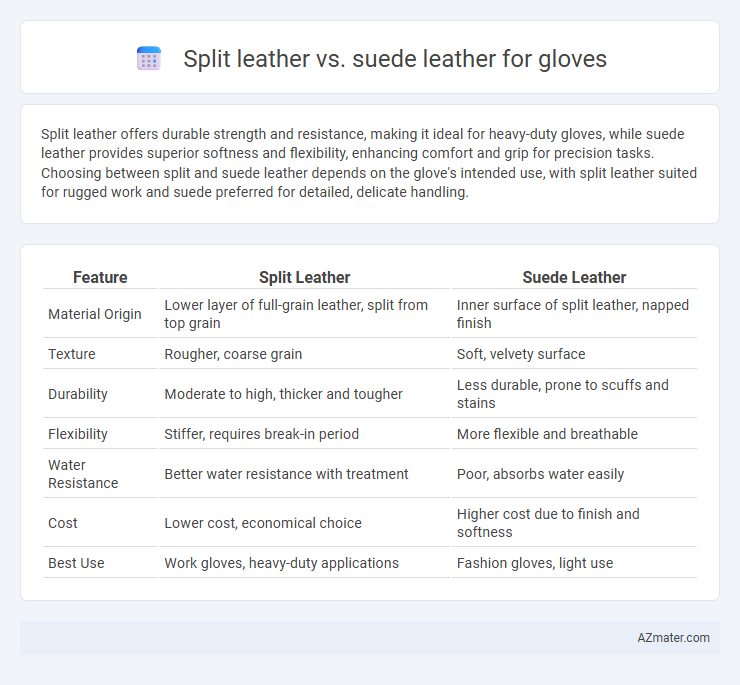Split leather offers durable strength and resistance, making it ideal for heavy-duty gloves, while suede leather provides superior softness and flexibility, enhancing comfort and grip for precision tasks. Choosing between split and suede leather depends on the glove's intended use, with split leather suited for rugged work and suede preferred for detailed, delicate handling.
Table of Comparison
| Feature | Split Leather | Suede Leather |
|---|---|---|
| Material Origin | Lower layer of full-grain leather, split from top grain | Inner surface of split leather, napped finish |
| Texture | Rougher, coarse grain | Soft, velvety surface |
| Durability | Moderate to high, thicker and tougher | Less durable, prone to scuffs and stains |
| Flexibility | Stiffer, requires break-in period | More flexible and breathable |
| Water Resistance | Better water resistance with treatment | Poor, absorbs water easily |
| Cost | Lower cost, economical choice | Higher cost due to finish and softness |
| Best Use | Work gloves, heavy-duty applications | Fashion gloves, light use |
Introduction to Split Leather and Suede Leather
Split leather originates from the fibrous lower layer of animal hides after the top grain is separated, offering durability and strength ideal for gloves requiring toughness. Suede leather is crafted from the inner surface of split leather, characterized by its soft, napped texture providing superior flexibility and comfort. Both materials serve distinct purposes in glove manufacturing, with split leather favored for rugged use and suede preferred for a supple, luxurious feel.
Defining Split Leather: Characteristics and Production
Split leather, derived from the fibrous lower layers of a hide separated from the top grain, features a rougher texture and is less durable than full-grain leather. It undergoes a splitting process where the hide is divided horizontally, creating layers that are then finished or coated to mimic smoother surfaces. Due to its porous nature, split leather is commonly used in glove manufacturing for enhanced flexibility and breathability, although it often requires additional treatments to improve water resistance and durability.
Understanding Suede Leather: Features and Creation
Suede leather for gloves is crafted from the underside of the hide, offering a soft, napped finish distinct from the rougher texture of split leather. Its porous surface provides superior breathability and flexibility, making suede gloves ideal for cold-weather wear and tasks requiring dexterity. Unlike split leather, which is derived from the fibrous inner layers of the hide and often treated for durability, suede emphasizes a plush feel and aesthetic appeal through its unique sanding and buffing process.
Texture and Appearance: Split vs Suede Leather
Split leather features a rougher, more fibrous texture due to the separation of the leather's inner layers, offering a sturdy and textured appearance ideal for durable gloves. Suede leather, crafted from the underside of the hide, provides a soft, napped surface with a velvety texture that enhances comfort and style in glove design. The fibrous grain of split leather contrasts with the smooth, matte finish of suede, making each suitable for different aesthetic and functional glove requirements.
Durability and Longevity Comparison
Split leather gloves offer superior durability compared to suede leather due to their denser fiber structure and thicker hide layers, making them ideal for heavy-duty tasks. Suede leather gloves, crafted from the underside of the hide, provide softer texture and flexibility but are more prone to wear and tear, reducing their longevity. For applications requiring extended glove lifespan and resistance to abrasion, split leather is the preferred material.
Comfort and Flexibility in Glove Use
Split leather gloves offer enhanced durability but tend to be stiffer and less breathable compared to suede leather gloves. Suede leather provides superior flexibility and a softer feel, increasing comfort during prolonged glove use. The increased pore structure in suede allows better air circulation, reducing hand sweat and improving overall glove comfort.
Water and Stain Resistance Properties
Split leather gloves offer superior water resistance due to their dense fiber structure and often treated surface, making them more suitable for wet conditions. Suede leather gloves, characterized by their napped finish from the underside of the hide, absorb water quickly and are more prone to staining, requiring additional waterproofing sprays for protection. The inherent texture of suede attracts dirt and moisture, whereas split leather's smoother grain provides enhanced durability against stains and moisture penetration.
Cost and Availability in the Market
Split leather gloves generally cost less than suede leather gloves due to lower processing requirements and the use of the lower layers of hide. Suede leather gloves are less readily available in the market as they require more specialized treatment and are often sourced from higher-quality split leather sections. Market availability of split leather gloves is widespread, making them a popular choice for budget-conscious consumers, while suede gloves cater to niche markets valuing texture and appearance.
Best Use Cases for Split and Suede Leather Gloves
Split leather gloves offer durability and resistance to wear, making them ideal for heavy-duty tasks such as construction, gardening, and industrial work where protection from abrasions is crucial. Suede leather gloves provide superior flexibility and breathability, perfect for lighter tasks including driving, casual wear, and precision handling where comfort and dexterity are prioritized. Choosing between split and suede leather gloves depends on the balance between toughness needed and comfort desired for specific activities.
Choosing the Right Leather Type for Your Gloves
Split leather offers durability and resistance, making it ideal for heavy-duty gloves used in construction and industrial work. Suede leather provides exceptional flexibility and a soft texture, enhancing comfort and dexterity for tasks requiring precision and fine motor skills. Choosing between split and suede leather depends on the balance needed between toughness and tactile sensitivity in glove use.

Infographic: Split leather vs Suede leather for Glove
 azmater.com
azmater.com